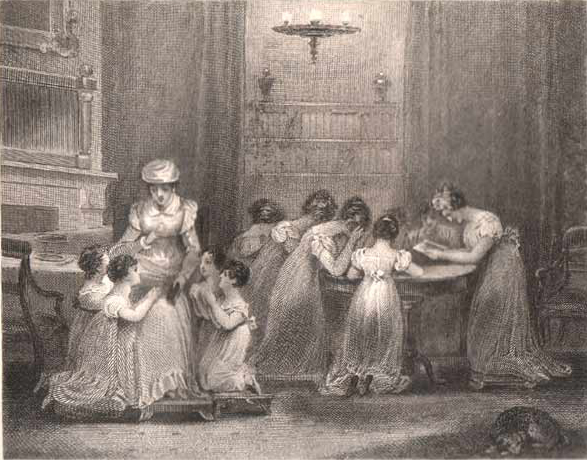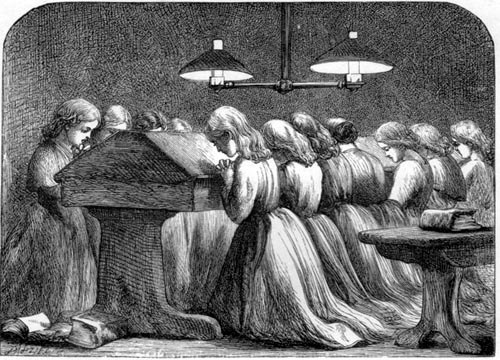
 |
|

from Forget Me Not (1826)
Victorian Web as accompanying Hemans' "Evening Prayer, at a Girls' School"
Now in thy youth, beseech of Him
Who giveth, upbraiding not;
That His light in thy heart become not dim,
And his love be unforgot;
And thy God, in the darkest of days, will be
Greenness, and beauty, and strength to thee.
–BERNARD BARTON.HUSH! 'tis a holy hour–the quiet room
Seems like a temple, while yon soft lamp sheds
A faint and starry radiance, through the gloom
And the sweet stillness, down on fair young heads,
With all their clustering locks, untouch'd by care,
And bow'd, as flowers are bow'd with night, in prayer.Gaze on–'tis lovely!–Childhood's lip and cheek,
Mantling beneath its earnest brow of thought–
Gaze–yet what seest thou in those fair, and meek,
And fragile things, as but for sunshine wrought?–
Thou seest what grief must nurture for the sky,
What death must fashion for eternity!O! joyous creatures! that will sink to rest,
Lightly, when those pure orisons are done,
As birds, with slumber's honey-dew opprest,
'Midst the dim folded leaves, at set of sun–
Life up your hearts! though yet no sorrow lies
Dark in the summer-heaven of those clear eyes.Though fresh within your breasts the untroubled springs
Of hope make melody where'er ye tread,
And o'er your sleep bright shadows, from the wings
Of spirits visiting but youth, be spread;
Yet in those flute-like voices, mingling low,
Is woman's tenderness–how soon her woe!Her lot is on you–silent tears to weep,
And patient smiles to wear through suffering's hour,
And sumless riches, from affection's deep,
To pour on broken reeds–a wasted shower!
And to make idols, and to find them clay,
And to bewail that worship–therefore pray!Her lot is on you–to be found untired,
Watching the stars out by the bed of pain,
With a pale cheek, and yet a brow inspired,
And a true heart of hope, though hope be vain;
Meekly to bear with wrong, to cheer decay,
And oh! to love through all things–therefore pray!And take the thought of this calm vesper time,
With its low murmuring sounds and silvery light,
On through the dark days fading from their prime,
As a sweet dew to keep your souls from blight!
Earth will forsake–O! happy to have given
The unbroken heart's first fragrance unto Heaven.
During the Romantic Period, the piety of a woman was one of her most treasured attributes. In her article, “The Cult of True Womanhood: 1820-1860,” Barbara Welter argues that “the attributes of True Womanhood, by which a woman judged herself and was judged by her husband, her neighbors and society could be divided into four cardinal virtues – piety, purity, submissiveness and domesticity” (152). Of these four virtues, “religion or piety was the core of woman’s virtues, the source of her strength… [It] belonged to woman by divine right, a gift of God and nature” (152). It is this emphasis on the virtue and strength found in piety that drives the subject matter of womanhood in “Evening Prayer at a Girl’s School.”
Through the use of Bernard Barton’s motto to preface the poem, there is immediately a great importance shed upon the need for dependence upon God. Barton is urging the girls, at their young age, to ask God to fill their hearts with the piety that will lead and guide them through the rest of their days because the poem “predicts that [they] will soon inherit woman’s burden of mingled joy and woe” (Hickok 27). He attributes the possession of piety in one’s heart to the possession of beauty and strength which are characteristics to be admired and hoped for. The speaker of the poem is speaking not only to the young girls in the engraving, but also indirectly to the young woman reading the poem. Having the poem coincide with the engraving allows Hemans to address both audiences – the young girls in the engraving and the young girls reading her poem.
The overall thematic structure of the poem seems to follow the maturity of a young girl into womanhood. This maturity is not viewed as a period of happiness and peace, but instead “the innocent happiness of the young girls is tragically contrasted with the misery that lies ahead for them when they grow to maturity and take on the sorrows and woes of woman’s lot” (Clarke 35). The first stanza evokes images of peace, much like the peace found in a sleeping child. Words such as “quiet,” “soft lamp,” and “sweet stillness,” gives the poem an innocent beginning. “Clustering locks” of hair is usually representative of a cherub, innocent and almost baby-like. This idea of innocence continues on into the second stanza, but the subject matter slowly progresses to one of grief and death in which the young girls will “sink” to rest after prayer. By using the word “sink” amidst other phrases such as “dim folded” and “set of sun,” the speaker gives a sense of inevitable sorrow that will slowly approach in the latter lives of the young girls.
Stanza four draws the emotions back to innocence, but only for a brief second because despite the youthful spirit and melodies of hope, it will be the “flute-like voices, mingling low” that will turn into the woe of “woman’s tenderness.” Through the first four stanzas, the young girls have grown from the innocence of childhood to a woman who is just on the verge of experiencing the inevitable woe of womanhood for in stanza five, the woman is called to bear “patient smiles” and a sense of joy in the trials of the “suffering’s hour,” representative of pregnancy, and the ever-challenging hardship of coping with “broken reeds” which seems to mean the death of an infant. The only possible solution that the speaker sees to offer is to pray. Prayer and the heart to love unconditionally through the hardships of motherhood is given as a remedy for the “pain,” “vain,” and “decay” found in stanza six. The speaker ends the poem with hope in knowing that the “unbroken” heart has been given its “first fragrance unto Heaven.” The young girls are urged to remember this moment in time that is spent in prayer in the calm of the evening because it will help them endure through the woes of womanhood that they have been aptly warned about.
Within seven short stanzas, Hemans is able to cycle through the important stages of womanhood and end back in the present time of the evening prayer. The engraving that accompanies the poem shows the three different stages of womanhood that are discussed in the poem. On the left side of the engraving are four little girls gathered around an older woman, most likely a teacher, who is leading them in prayer. These girls are depicted almost in a cherubim-like fashion with the curly hair and plump appearance. The larger group of girls are in their adolescent years, but are still being led by a woman who seems only slightly older than them. In following Romantic tradition, all of the women, except the older woman surrounded by the little girls, are drawn with smooth, exposed necklines. There is only one woman whose whole face is seen and who is not in a prayer position like the rest. This woman, most likely a teacher figure, is representative of the model woman of piety that the girls should strive to become. With her hand over her heart, there is an added sense of sincerity and virtue in whatever she is telling them. The room they occupy is so simple and serene that it “seems like a temple” (stanza 1). The poem and engraving, which would lose their effectiveness if separated, work together to portray the need for piety and prayer in the demanding life of a young girl soon to experience womanhood.
**Bibliographic entries for citations can be found in the Annotated Bibliography section**
All links to Image Sources can be found in the "Annotated Bibliography"section.